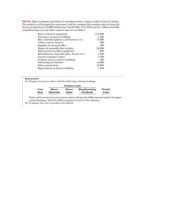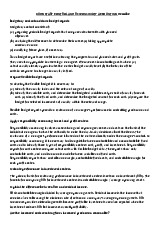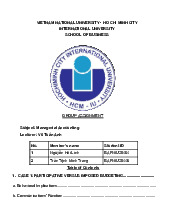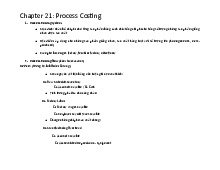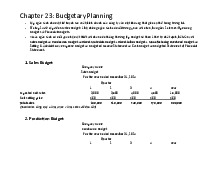














Preview text:
lOMoAR cPSD| 58605085 Chapter 23
Budget: a formal written statement of management’s plans for a specified future time period, expressed in financial terms.
Budgeting and Accounting
• Historical accounting data on revenues, costs, and expenses help in formulating future budgets.
• The budget and its administration are the responsibility of management.
The Benefits of Budgeting •
Requires all levels of management to plan ahead. •
Provides definite objectives for evaluating performance. •
Creates an early warning system for potential problems. •
Facilitates coordination of activities within the business. •
Results in greater management awareness of the entity’s overall operations. •
Motivates personnel throughout organization to meet planned objectives. Review
Which of the following is not a benefit of budgeting? a. Management can plan ahead.
b. An early warning system is provided for potential problems.
c. It enables disciplinary action to be taken at every level of responsibility.
d. The coordination of activities is facilitated.
Length of the Budget Period • Most common - one year
• Different budgets may cover different time periods The Budgeting Process
• Base budget goals on past performance
• Develop budget within the framework of a sales forecast
Budgeting and Human Behavior
Participative Budgeting: Each level of management should be invited to participate. lOMoAR cPSD| 58605085 • Advantages:
o More accurate budget estimates because lower level managers have more detailed knowledge of their area.
o Tendency to perceive process as fair due to involvement of lower level management. • Disadvantages:
o Can be time consuming and costly.
o Can foster budgetary “gaming” through budgetary slack.
Essentials of Effective Budgeting:
• Depends on a sound organizational structure with authority and responsibility for all phases
of operations clearly defined.
• Based on research and analysis with realistic goals.
• Accepted by all levels of management. Review
The essentials of effective budgeting do not include: a. Top-down budgeting. b. Management acceptance. c. Research and analysis.
d. Sound organizational structure. The Master Budget
• Set of interrelated budgets that constitutes a plan of action for a specified time period
• Contains two classes of budgets:
o Operating budgets: Individual budgets that result in the preparation of the budgeted
income statement – establish goals for sales and production personnel.
o Financial budgets: The capital expenditures budget, the cash budget, and the
budgeted balance sheet – focus primarily on cash needs to fund operations and capital expenditures. lOMoAR cPSD| 58605085
Preparing the Operating Budgets 1. Sales budget • First budget prepared
• Derived from the sales forecast
• Every other budget depends on the sales budget
Total sales = expected unit sales x unit selling price
Illustration – Hayes Company
• Expected sales volume: 3,000 units in the first quarter with 500-unit increases in each
succeeding quarter.
• Sales price: $60 per unit. lOMoAR cPSD| 58605085 2. Production Budget
• Shows units that must be produced to meet anticipated sales.
• Derived from sales budget plus the desired change in ending finished goods inventory.
• Essential to have a realistic estimate of ending inventory. • Units from sales budget
Hayes Co. believes it can meet future sales needs with an ending inventory of 20% of
next quarter’s sales.
Note: Cuối kì này là đầu kì sau
Direct Materials Budget: units from production budget
Budgeted cost of direct materials to be purchased = required units of direct materials x
anticipated cost per unit.
Because of its close proximity to suppliers, lOMoAR cPSD| 58605085
• Hayes Company maintains an ending inventory of raw materials equal to 10% of the
next quarter’s production requirements.
• The manufacture of each Rightride requires 2 pounds of raw materials, and the expected
cost per pound is $4.
• Assume that the desired ending direct materials amount is 1,020 pounds for the fourth
quarter of 2011.
Prepare a Direct Materials Budget.
Ex 1: Soriano Company is preparing its master budget for 2014. Relevant data pertaining to its
sales, production, and direct materials budgets are as follows:
Sales: Sales for the year are expected to total 1,200,000 units. Quarterly sales are 20%, 25%,
30%, and 25% respectively. The sales price is expected to be $50 per unit for the first three
quarters and $55 per unit beginning in the fourth quarter. Sales in the first quarter of 2015 are
expected to be 10% higher than the budgeted sales for the first quarter of 2014.
Production: Management desires to maintain ending finished goods inventories at 25% of next
quarter’s budgeted sales volume.
Direct materials: Each unit requires 3 pounds of raw materials at a cost of $5 per pound.
Management desires to maintain raw materials inventories at 5% of the next quarter’s
production requirements. Assume the production requirements for the first quarter of 2015 are
810,000 pounds. lOMoAR cPSD| 58605085
Prepare the sales, production, and direct materials budgets by quarters for 2014. Sales Budget Quarter 1 2 3 4 Year Expected unit sales 240,000 300,000 360,000 300,000 1,200,000 Unit selling price 50 50 50 55 Total sales $12,000,000 15,000,000 18,000,000 16,500,000 61,500,000
P roduction Budget Quarter 1 2 3 4 Year Expected unit sales 240,000 300,000 360,000 300,000 Add: Desired ending 75,000 90,000 75,000 66,000 finished goods units (25% of next quarter) (The first-quarter 2015 sales unit = 240,000 x (1 + 10%) = 264,000) (Quarter 4 2014 = 264,000 x 25%) = 66,000 units) Total required units 315,000 390,000 435,000 366,000 Less: Beginning finished 60,000 75,000 90,000 75,000 goods units (25% of estimated firstquarter 2014 sales units = 240,000 x 25%)
Required production units 255,000 315,000 345,000 291,000 1,206,000 lOMoAR cPSD| 58605085
Direct Labor Budget: units from production budget
Direct labor hours are determined from the production budget. At Hayes Company, two hours
of direct labor are required to produce each unit of finished goods. The anticipated hourly wage rate is $10.
Manufacturing Overhead Budget: lOMoAR cPSD| 58605085
• Units from direct labor budget
• Distinguishes between fixed and variable overhead costs.
Hayes Company expects variable costs to fluctuate with production volume on the basis of the
following rates per direct labor hour: indirect materials $1.00, indirect labor $1.40, utilities
$0.40, and maintenance $0.20. Thus, for the 6,200 direct labor hours to produce 3,100 units,
budgeted indirect materials are $6,200 (6,200 x $1), and budgeted indirect labor is $8,680 (6,200
x $1.40). Hayes also recognizes that some maintenance is fixed. The amounts reported for fixed
costs are assumed.
Prepare a Manufacturing Overhead Budget.
3. Selling and Administrative Expense Budget
• Distinguishes between fixed and variable costs. • Units from sales budget
Variable expense rates per unit of sales are sales commissions $3 and freight-out $1. Variable
expenses per quarter are based on the unit sales from the sales budget (Illustration 9-3). Hayes
expects sales in the first quarter to be 3,000 units. Fixed expenses are based on assumed data. lOMoAR cPSD| 58605085
Prepare a selling and administrative expense budget. Review
A sales budget is:
a. Derived from the production budget.
b. Management’s best estimate of sales revenue for the year.
c. Not the starting point for the master budget.
d. Prepared only for credit sales.
Budgeted Income Statement
• Important end-product of the operating budgets.
• Indicates expected profitability of operations.
• Provides a basis for evaluating company performance. lOMoAR cPSD| 58605085
• Prepared from the operating budgets: o Manufacturing Overhead o
Selling and Administrative Expense o Sales o Direct Materials o Direct Labor
To find the cost of goods sold, it is first necessary to determine the total unit cost of producing
one Rightride, as follows.
Determine Cost of Goods Sold by multiplying units sold times unit cost:
COGS = Total unit cost x unit sold (from sale budget) 15,000 units x $44 = $660,000
All data for the income statement come from the individual operating budgets except the
following: (1) interest expense is expected to be $100 and (2) income taxes are estimated to be $12,000. lOMoAR cPSD| 58605085 Review
Each of the following budgets is used in preparing the budgeted income statement except the: a. Sales budget.
b. Selling and administrative budget.
c. Capital expenditure budget.
d. Direct labor budget.
Ex 2: Jingsung Industries is preparing its budgeted income statement for 2014. Relevant data
pertaining to its sales, production, and direct materials budgets can be found in Ex 1.
In addition, Jingsung Industries 0.5 hours of direct labor per unit, labor costs at $15 per hour,
and manufacturing overhead at $25 per DLH. Its budgeted selling and administrative expenses
for 2014 are $12,000,000. Sales revenues is $61,500,000, units from sales are 1,200,000 units.
a. Calculate the budget total unit cost.
b. Prepare the budgeted multiple-step income statement for 2014. (Ignore income taxes.) Cost element Quantity Unit cost Total DM 3.0 pounds $5 $15 DL 0.5 hours 15 $7.5 MOH 0.5 hours 25 $12.5 Total unit cost $35
Budgeted Income Statement Sales 61,500,000 COGS (1,200,000 x 35) (42,000,000) Gross profit 19,500,000
Selling and administrative expenses (12,000,000) Net income $7,500
Preparing the Financial Budgets lOMoAR cPSD| 58605085 1. Cash budget Contains three sections: • Cash Receipts • Cash Disbursements • Financing
Cash Receipts Section
• Expected receipts from the principal sources of revenue.
• Expected interest and dividends receipts, proceeds from planned sales of investments,
plant assets, and capital stock. Cash Disbursements Section
• Expected cash payments for direct materials and labor, taxes, dividends, plant assets, etc. Financing Section
• Expected borrowings and repayments of borrowed funds plus interest. lOMoAR cPSD| 58605085
Note: Depreciation expense: non-cash expense
Twiw Ltd. Management wants to maintain a minimum monthly cash balance of $450,000. At
the beginning of March, the cash balance is $495,000, expected cash receipts for March are
$6,300,000, and cash disbursements are expected to be $6,600,000. How much cash, if any,
must be borrowed to maintain the desired minimum monthly balance? Cash Budget Beginning cash balance $495,000 Add: Cash receipts for March 6,300,000 Total available cash 6,795,000
Less: Cash disbursements for March (6,600,000)
Excess (deficiency) of available cash over cash 195,000 disbursements Financing 255,000 Ending cash balance $450,000 lOMoAR cPSD| 58605085
2. Budgeted Balance Sheet Merchandisers
• Sales Budget: starting point and key factor in developing the master budget.
• Use a purchases budget instead of a production budget.
• Does not use the manufacturing budgets (direct materials, direct labor, manufacturing overhead).
Illustration: Lima’s budgeted sales for July $300,000 and for August $320,000. Cost of Goods
Sold: 70% of sales. Desired ending inventory is 30% of next month’s Cost of Goods Sold.
Required merchandise purchases for July are computed as follows. lOMoAR cPSD| 58605085
